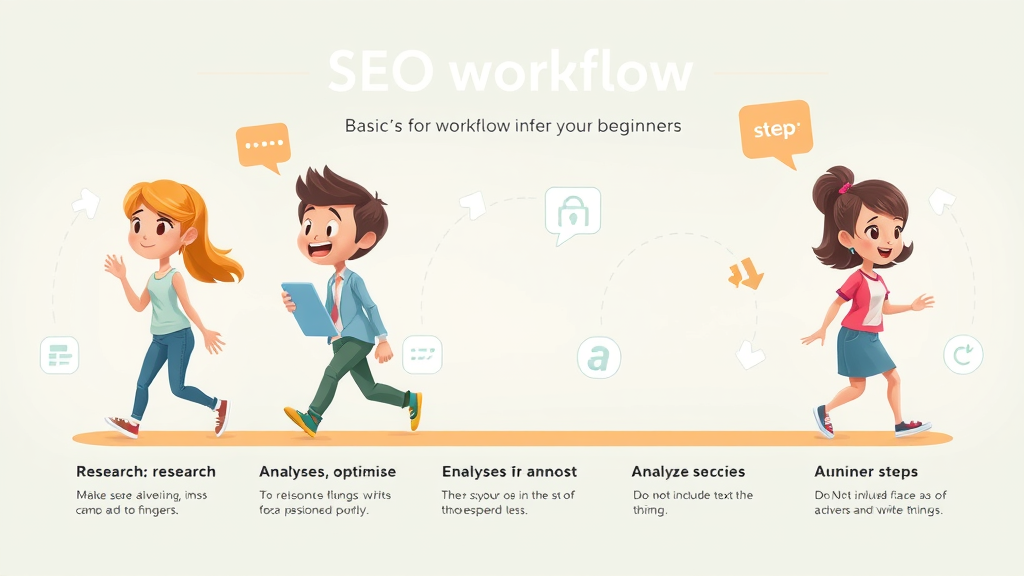Here's something astounding: over 90% of online experiences begin with a search engine . Still, only a fraction of websites truly capitalize on the power of search engine optimization (SEO) to harness traffic and drive growth. Are you ready to move your site up the search engine results page and into the spotlight? This guide reveals proven SEO strategies, debunks technical myths, and uncovers the real steps you need to grow traffic—starting today.

The Power of Search Engine Optimization: Transform Your Website’s Potential
- Did you know that over 90% of online experiences begin with search engines? Unveil how search engine optimization can be the catalyst for unprecedented traffic and results on your website.
Search engine optimization (SEO) is the driving force behind organic traffic—the visitors who find your website through natural search results, instead of paid ads. Many businesses pour resources into slick designs and branding, only to discover that their web pages get lost deep in search engine results. By mastering SEO, you unlock a steady flow of high-quality traffic searching exactly for what you offer. Just as importantly, strong rankings position your brand as a credible authority, boosting trust and conversion rates along the way.
In this guide, we’ll cover how SEO works to transform your site's potential, exploring how technical SEO, keyword research, and social media solidify your online presence. Whether you’re aiming to rank higher in Google search or carve out a niche in competitive markets, understanding search engine optimization is your gateway to online success.
Unlocking Success: What Mastering Search Engine Optimization Will Teach You
- Why search engine optimization is essential in today’s digital landscape
- How the main types of SEO impact your strategy
- Step-by-step best practices for optimization
- Practical tips for enhancing user experience and technical SEO
- Ways to connect with audiences across search engines and social media
You’ll discover why SEO is still the most cost-effective strategy for driving sustainable online growth . By understanding the interplay between on-page (content and structure), off-page (backlinks and reputation), technical SEO (site speed, mobile optimization), and local SEO (maps and directories), you’ll gain a roadmap designed for results. More than just theory, this guide is packed with step-by-step strategies: from brainstorming keywords and optimizing your meta descriptions, to implementing best practices in technical SEO that ensure fast, secure browsing experiences.
Plus, you’ll learn to boost your site’s reach through effective engagement with social media , giving you an edge over competitors who rely on one channel. No more feeling left behind—mastering search engine optimization will illuminate clear SEO work paths for all skill levels, putting you in command of your online destiny.
Decoding Search Engine Optimization: Foundations and Key Concepts
What is Search Engine Optimization? Understanding Search Engines and SEO Fundamentals

Search engine optimization means optimizing your website so that search engines like Google, Bing, and Yahoo understand its content and prioritize it for relevant search queries . Search engines use advanced algorithms to crawl, index, and rank millions of web pages, evaluating factors like keyword relevance, content quality, page load speed, and backlinks.
Effective SEO work helps your content appear near the top of the search results page , increasing visibility for users seeking information, products, or services you offer. By implementing foundational SEO principles—such as proper use of meta tags, keyword placement, and intuitive site architecture—you signal to search engines that your content deserves to rank high. Understanding how search engines operate ensures every part of your website, from blog posts to landing pages, is strategically crafted to attract organic search traffic.
The essence of search engine optimization comes down to two objectives: aligning your web pages with both user intent and search engine algorithms. This synergy boosts rankings, expands market share , and turns your site into a magnet for targeted, high-intent visitors.
The Importance of Search Engines in Online Visibility and Business Growth
With billions of searches conducted every day, search engines have become the main gateway to the internet. Appearing prominently in engine results pages means more potential customers discover your services, leading directly to increased organic traffic and revenue.
For businesses large and small, effective engine optimization translates into lower marketing costs, exponential traffic growth, and stronger brand recognition. Companies that invest in robust SEO strategies often see higher conversion rates than those relying solely on paid ads or traditional marketing avenues. In today’s competitive landscape, search engine rankings not only build trust with audiences but also serve as a measurable indicator of credibility and authority.
Whether you run a niche blog, local business, or e-commerce store, focusing on SEO ensures a sustainable flow of leads. Visibility on search engine results pages (SERPs) is the difference between stagnation and real business growth . Mastering SEO is not an option—it's a necessity for survival and expansion in the digital age.
Types of Search Engine Optimization: On-Page, Off-Page, Technical, and Local SEO
Search engine optimization covers four main areas, each essential for comprehensive digital growth. On-page SEO involves optimizing individual web pages for keyword relevance, meta descriptions, images, and internal linking—directly improving your pages for both users and search engines. Off-page SEO focuses on building your site's reputation through backlinks and social media shares, showing search engines that your content is credible and authoritative.
Technical SEO addresses the behind-the-scenes elements: site speed, mobile usability, structured data, and security—all vital for crawlability and ranking. Lastly, local SEO targets geographical queries, ensuring your business is visible in local searches and maps. Each type works in unison, creating a holistic engine optimization plan that maximizes visibility and traffic across the board.
| SEO Type | Main Focus | Key Tactics | Best For |
|---|---|---|---|
| On-Page SEO | Content & Keywords | Keyword research, meta descriptions, title tag optimization, internal links | Improving individual web pages |
| Off-Page SEO | Backlinks & Reputation | Link building, social media sharing, external mentions | Establishing authority and trust |
| Technical SEO | Site Performance | Mobile optimization, site speed, structured data, SSL security | Supporting site health and crawlability |
| Local SEO | Geographic Relevance | Google My Business, NAP consistency, local directories | Boosting local search visibility |

"SEO is no longer just about keywords and links – it’s about delivering user experience and value to both people and search engines."
How to Start Search Engine Optimization: A Beginner-Friendly SEO Roadmap
Conducting Effective Keyword Research for Engine Optimization

Every successful search engine optimization campaign starts with keyword research . Identifying the terms and phrases your target audience is searching for is critical—these keywords inform not just your content, but your entire SEO work strategy. Using tools like Google Keyword Planner, Ahrefs, or SEMrush, dig for those high-traffic, low-competition keywords that can help you rank high in your niche.
Analyze related search queries, competitor web pages , and autocomplete suggestions to refine your list. Remember, choosing the right keywords goes beyond sheer volume—focus on search intent and how well a keyword fits your site’s value proposition. Long-tail keywords (three or more words) can help target specific groups, increasing your chances of ranking higher on engine results pages and capturing engaged visitors.
Solid keyword research shapes every subsequent SEO action, from meta description writing to internal linking. Make it a continuous process: as your site grows, update your keywords to keep up with changing search engine trends and audience needs.
Crafting Meta Descriptions and Optimizing Title Tags for Search Engines
Well-crafted meta descriptions and title tags are among the first things users and search engines notice in the search engine results page. A title tag should be concise, descriptive, and include your main keywords early on. It not only captures attention but also signals to search engines what your content is about, influencing your engine ranking.
Meta descriptions, shown under the title in search results, should be persuasive and accurately summarize the page’s content while using target keywords naturally. Keep them between 150-160 characters. Both meta descriptions and title tags help improve click-through rates—turning impressions into actual organic traffic. For each web page , avoid duplicates and ensure all metadata uniquely reflects its content.
Don’t overlook these basics: regularly updating meta descriptions and title tags ensures your site stays relevant as search engine algorithms evolve. This ongoing optimization is foundational SEO work for sustaining high search engine rankings .
SEO Work for Beginners: Simple Steps to Rank Higher in Google Search
- Brainstorming keyword ideas
- Analyzing competitor websites
- Optimizing your website’s structure
- Writing persuasive meta descriptions

For newcomers to search engine optimization , it’s easy to get overwhelmed. Start simple: brainstorm a list of keywords related to your business and services. Then, analyze how competitors structure their web pages, which keywords they target, and how they format their meta descriptions.
Next, optimize your site’s architecture. Make sure your main pages are easily reachable from the homepage, use descriptive URLs, and create internal links that distribute authority throughout your site. Write compelling, keyword-rich meta descriptions for every page and title tag. Small and steady improvements—such as adding relevant content, fixing broken links, and ensuring mobile readability—collectively boost your site’s SEO performance over time.
Consistency in execution is key: check your Google Search Console to track engine rankings, monitor search traffic, and spot errors before they become issues. These beginner steps set the stage for long-term SEO work success.
Deep Dive: Technical SEO and User Experience for Search Engine Optimization
Essential Elements of Technical SEO for Enhanced Search Engine Performance

Technical SEO is the backbone of successful search engine optimization. Without a solid technical foundation, even the best content may struggle to rank high or appear in search results. Focus first on site speed —a faster site keeps users engaged and sends positive signals to search engines. Use tools like Google PageSpeed Insights to pinpoint lagging elements.
Mobile-friendliness is equally essential. With increasing numbers of users searching on smartphones, a responsive site not only improves user experience, but is now a direct ranking factor in Google search. Structured data (Schema.org) helps engines understand and properly display your content, powering rich results in the engine results page.
Other technical must-haves include HTTPS security, XML sitemaps, optimized URL structure, and fixing crawl errors reported in Google Search Console. Addressing these technical SEO elements makes your site more accessible to both users and search engines, setting the stage for long-term ranking and indexing success.
Improving User Experience: How it Impacts Search Engine Optimization Success
An exceptional user experience (UX) is integral to modern search engine optimization . Clean navigation, fast loading times, readable content, and logical on-page structure encourage users to stay longer and engage with your site. This boosts behavioral signals—like low bounce rates and higher dwell times—that search engines take into consideration when ranking pages.
UX goes hand-in-hand with SEO work : a well-organized website helps both users and search engine bots find and understand your content. Design intuitive menus, use helpful calls-to-action, and provide instant access to valuable resources to enhance UX. Small touches, like mobile-friendly buttons or easier forms, can make a huge difference in keeping visitors on your site and improving search engine rankings.
Prioritizing user experience not only pleases your visitors but also aligns with search engine algorithms increasingly focused on delivering value, access, and ease of use. Continuous improvements in UX directly contribute to increased organic traffic and conversion rates.
Mobile Optimization, Site Speed, and Security for Search Engine Rankings
In today’s mobile-first world, mobile optimization is non-negotiable for search engine optimization. Search engines give preference to sites that offer seamless experiences on all devices, especially smartphones and tablets. Ensure your website layout, images, and interactive elements all adapt fluidly to smaller screens.
Site speed is another major engine ranking factor. Compress images, leverage browser caching, and minimize scripts to decrease load times. Even a one-second delay can reduce conversions and increase bounce rates sharply, impacting your search engine rankings.
Don’t forget website security—search engines like Google prioritize HTTPS sites in rankings. A secure site keeps visitors safe and signals to search engines that you’re serious about protecting your users. Regularly audit your site’s technical health to maintain high search engine rankings and earn users’ trust.
Building Authority: Off-Page Search Engine Optimization Strategies and Social Media’s Role
Understanding Backlinks and Their Impact on Search Engines
Off-page SEO isn’t just about what happens on your website—it’s about building authority across the internet. Backlinks —links from external sites to your content—are viewed by search engines as votes of confidence. The more authoritative, relevant sites that link to you, the higher your search engine rankings can climb.
Quality matters more than quantity: a single backlink from a respected source can outweigh dozens from low-value sites. Earn backlinks by publishing valuable, shareworthy content, guest posting, and building relationships within your industry. Track your backlink profile regularly to disavow toxic links that might harm your ranking.
Effective backlink strategies elevate your engine optimization efforts, enhancing trust, visibility, and organic traffic growth. Remember, links aren’t just for search engines—referral traffic can become a major source of leads and conversions.
Leveraging Social Media for Broader Engine Optimization Reach
Social media may not be a direct ranking factor, but its influence on search engine optimization is hard to overstate. When users share, like, and discuss your content across platforms like Facebook, Twitter, and LinkedIn, you expand its reach and potential for inbound links. Viral social content also drives traffic to your website, signaling to search engines that your pages are valuable and relevant.
Build a consistent brand presence by sharing your latest posts, engaging with your audience, and encouraging others to share your content. Embed social sharing buttons on your web pages and stay active in relevant communities. Trends seeded on social media often end up in increased search queries, improving your content’s opportunity to appear in the search results page.
When combined with your core SEO work, social media can multiply your visibility and reinforce your authority within your industry—crucial for businesses seeking a larger slice of market share.

Reputation Management and Online Visibility with Search Engine Optimization
In a saturated market, reputation management is at the heart of search engine optimization. Monitoring your brand mentions, soliciting honest reviews, and responding proactively to feedback protects and enhances your online image. Positive reviews not only boost trust among new visitors but also increase your authority in the eyes of search engines.
Use SEO work to suppress negative results and clarify your unique value proposition. Content marketing plays a big part: share company milestones, positive stories, and customer testimonials on both your site and social media. This integrated approach ensures that when people search for your business, the picture they see inspires confidence and action.
Invest in building a stellar reputation—it’s both a defensive and offensive tactic in the race to the top of the engine results page.
Advanced Tools and Analytics in Search Engine Optimization
Top SEO Tools for Tracking Progress and Google Search Performance

To maximize your search engine optimization success, you’ll need actionable insights provided by advanced analytics tools. Google Search Console and Google Analytics offer foundational data about search queries, clicks, and site health. Paid platforms like Ahrefs, SEMrush, and Moz provide deeper analysis—tracking keyword rankings, backlink profiles, and competitor SEO work.
Harness the power of these tools to identify top-performing content, technical issues, and fresh opportunities for optimization. Set up regular reports and dashboards to monitor engine rankings and organic traffic fluctuations. By staying data-driven, you can adapt fast to search engine algorithm updates and stay ahead in competitive niches.
No matter your budget, integrate at least one analytics tool into your regular SEO workflow. The insights uncovered here are the key to smart decision-making and refining your engine optimization strategies for even greater results.
Measuring Success: Key Metrics and Analytics for Search Engine Optimization
Tracking progress in search engine optimization is all about the right metrics. Bounce rate , click-through rate (CTR), conversion rate, and average ranking position reveal how users interact with your site and how well your SEO work is performing. Monitor these over time to spot trends, identify bottlenecks, and set realistic growth goals.
Analyzing metrics allows for rapid, data-backed improvements. For example, a spike in bounce rate might signal poor user experience or irrelevant content, while an uptick in organic search traffic means your keyword targeting strategy is paying off. Always align your analytics with business objectives—more traffic is only valuable if it leads to higher conversions and revenue.
| Metric | What it Measures | Importance |
|---|---|---|
| Bounce Rate | Percentage of visitors leaving after viewing one page | Indicates content relevance & user engagement |
| Click-Through Rate (CTR) | Percentage of impressions resulting in clicks | Measures how compelling your titles/descriptions are in search results |
| Conversion Rate | Percentage of visitors taking desired action (e.g., purchase, sign-up) | Reveals real business impact of SEO campaigns |
| Organic Traffic | Number of visitors from search engines (not paid ads) | Shows effectiveness of your SEO efforts at attracting new users |
| Average Position | Your average ranking in search results | Helps gauge keyword and page performance over time |
Troubleshooting Common Search Engine Optimization Challenges
How to Recover from Google Penalties and Avoid Common SEO Mistakes
Even seasoned pros make SEO mistakes, but fast recovery is possible. Common pitfalls include keyword stuffing, low-quality backlinks, duplicate content, and ignoring technical SEO. Google penalties—manual or algorithmic—can dramatically reduce your site’s visibility in search results.
To recover, start by conducting a comprehensive site audit using Google Search Console and a trusted SEO tool. Address all errors: remove or disavow bad backlinks, update thin or duplicate content, and resolve crawl and mobile usability issues. Focus on delivering real value to users—a well-rounded, helpful site is the best defense against future penalties.
Avoid shortcuts or “black hat” tactics; instead, build a solid, sustainable SEO foundation with white-hat strategies. Stay updated on Google algorithm changes and continuously update your SEO work as search engine optimization evolves.
Future-Proofing Your Search Engine Optimization Strategy: What’s Next?
The future of search engine optimization is in adaptability. With AI shaping search engines and evolving user behavior, focus on high-quality content, semantic search, and deeper technical optimization. Embrace new formats—like video and voice search—as user expectations shift.
Stay informed about Google’s latest updates and invest in ongoing learning. The best-performing websites continuously monitor data, refine strategies, and experiment with emerging trends. Future-proof SEO by putting users first and pairing creativity with evidence-based optimization.
Expert Insights on Search Engine Optimization: Industry-Leading Quotes
"In the age of AI and ever-changing algorithms, mastering search engine optimization is a continuous journey, not a one-time achievement."
Step-by-Step Video Tutorials for Effective Search Engine Optimization
People Also Ask about Search Engine Optimization
How to do SEO for beginners?
- Start with simple keyword research, optimize your content using relevant terms, focus on creating valuable user experiences, and ensure your website is technically sound and mobile-friendly. Monitor your progress using common SEO tools and adjust your strategy based on analytics.
What is meant by search engine optimization?
- Search engine optimization (SEO) is the practice of enhancing a website’s content, structure, and backlinks to increase its visibility and ranking in search engine results pages (SERPs). The ultimate goal is to attract organic, targeted traffic.
What are the 4 types of SEO?
- The four main types of SEO are: On-Page SEO (content/keywords/meta), Off-Page SEO (backlinks), Technical SEO (site speed/mobile/security), and Local SEO (maps/local directories).
Can I do SEO on my own?
- Yes, you can do search engine optimization on your own by learning best practices, staying updated on search algorithm changes, and using free or paid SEO tools to guide your improvements.
Frequently Asked Questions about Search Engine Optimization
- How long does search engine optimization take to show results?
- Are there risks of ranking penalties?
- What is white hat vs. black hat SEO?
- How does content quality affect engine optimization?
- How to keep up with Google search algorithm updates?
Key Takeaways for Mastering Search Engine Optimization
- Start with strong keyword research for search engine success
- Prioritize user experience and technical SEO
- Combine on-page, off-page, and content-driven strategies
- Track your results and iterate your search engine optimization plan
Take Your Website Higher: Start Your Search Engine Optimization Journey Now
Put these best practices into action and witness the transformation in your search engine optimization results. Keep learning, keep optimizing, and your website will rise to claim the success it deserves.
Sources
- https://moz.com/beginners-guide-to-seo
- https://developers.google.com/search/docs/fundamentals/seo-starter-guide
- https://ahrefs.com/blog/seo-basics/
- https://semrush.com/blog/seo/
- https://searchengineland.com/guide/what-is-seo
To deepen your understanding of search engine optimization (SEO) and enhance your website’s performance, consider exploring the following authoritative resources:
-
“SEO Starter Guide: The Basics” by Google Search Central provides foundational insights into SEO practices, including technical optimization, content strategies, and user experience enhancements. ( developers.google.com )
-
“What Is SEO - Search Engine Optimization?” by Search Engine Land offers a comprehensive overview of SEO, covering technical optimization, content strategies, and off-site optimization techniques. ( searchengineland.com )
These resources will equip you with the knowledge and tools necessary to effectively optimize your website and improve its search engine rankings.
 Add Row
Add Row  Add
Add 


Write A Comment